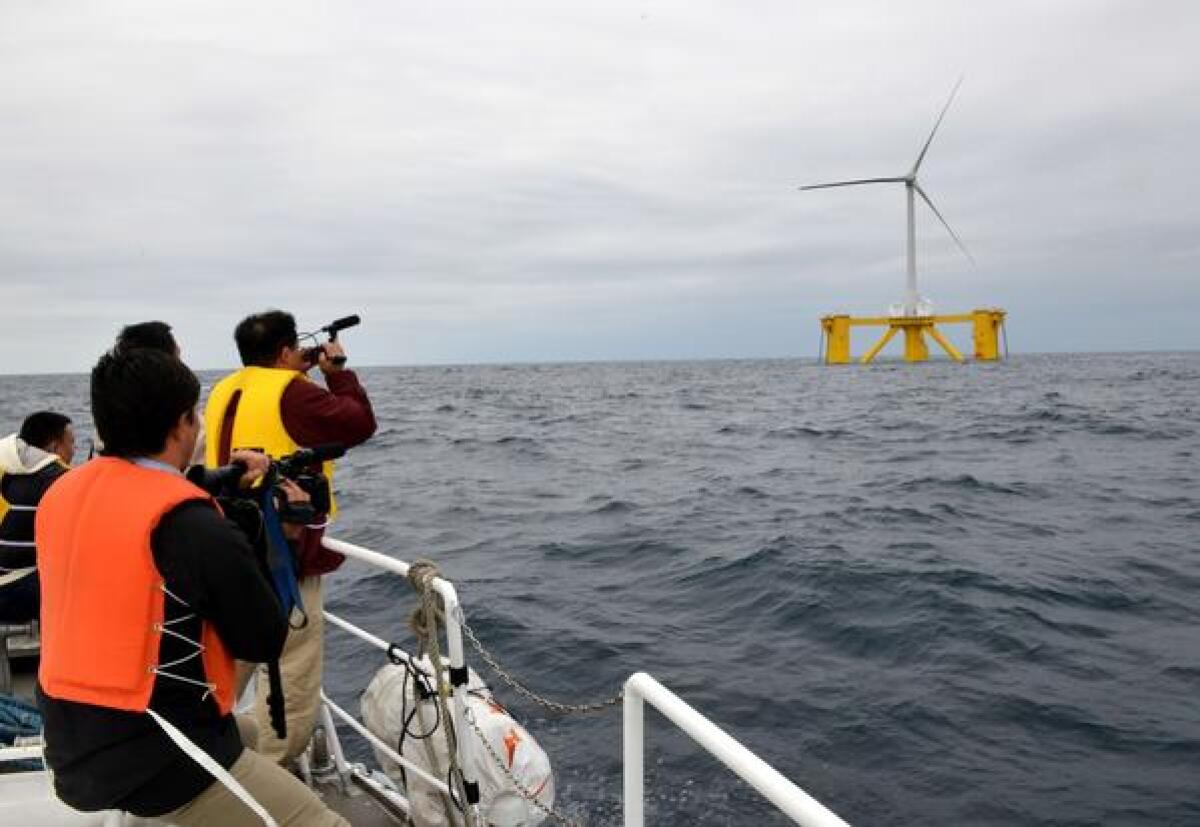With nuclear plants idled, Japan launches pioneering wind project

- Share via
Japan inaugurated a floating offshore wind turbine Monday that energy industry leaders hope will open a new frontier in Japanese renewable technologies and help the country reduce its dependence on nuclear energy and fossil fuels.
The floating platform is anchored 13 miles offshore from the crippled Fukushima Daiichi nuclear power plant, the scene of earthquake, tsunami and reactor meltdown disasters in March 2011.
The platform, anchored to the seabed 400 feet below the surface, is the first project of its kind in Japan, and is intended to show that emerging energy technologies can take advantage of powerful offshore winds despite the challenging ocean depths around most of the island country.
Electricity generated by the new 2,000-kilowatt wind turbine is relayed at the adjacent floating substation to an underwater cable and distributed to about 600 households by Tohoku Electric Power Co., the Jiji Press agency said.
The project, which envisions two additional floating turbines next year with 7,000-kilowatt capacity each, is a joint public-private undertaking by the Economy, Trade and Industry Ministry, the University of Tokyo and 10 major industrial enterprises.
Japan’s wind energy potential could generate 1,570 gigawatts, or five times current national electricity output, the Japan Daily Press said in its report on the turbine start-up. It hailed the project as reflecting the hope that nuclear power, which supplied nearly one-third of Japan’s electricity needs before the Fukushima disaster, can be significantly reduced or phased out.
All 50 of Japan’s nuclear reactors are shut down or inoperable following the March 11, 2011, disasters that began with a magnitude 9 earthquake, which triggered the tsunami that smashed through retaining walls at the four-reactor Fukushima complex. Electrical utilities have already petitioned the government to restart 14 of the idled reactors following safety retrofits and more stringent regulations put in place after the Fukushima meltdowns.
But opposition to nuclear operations remains strong among Japanese. The government in power before Prime Minister Shinzo Abe took office 11 months ago had pledged to phase out nuclear power over the next 30 years, although there has been political backtracking on that idea under the new conservative government.
Local officials at Monday’s ceremonial launch of the floating turbine project said it represented an opportunity for nuclear industry workers in the region to find new careers in renewables.
“Fukushima is making a stride toward the future step by step,” Fukushima prefecture Gov. Yuhei Sato told industry and political leaders gathered for an opening ceremony in the port of Iwaki. “Floating offshore wind is a symbol of such a future.”
Japan also recently opened the country’s largest solar energy project in Kagoshima prefecture, at Japan’s southern tip.
The wind turbine project will be accompanied by an environmental impact assessment to determine the potential consequences for Japan’s vital fisheries industry, broadcaster NHK reported. It quoted the head of a local fisheries cooperative, Hiroyuki Sato, as saying that trawling operations would be hindered by any major ramping up of the floating platforms and the heavy chains and anchors positioning them over the seabed.
ALSO:
U.S., EU resume negotiations on free trade agreement
Palestinians mark anniversary of Arafat’s death, blame Israel
Typhoon-ravaged Philippines declares ‘state of national calamity’
Twitter: @cjwilliamslat
More to Read
Sign up for Essential California
The most important California stories and recommendations in your inbox every morning.
You may occasionally receive promotional content from the Los Angeles Times.














